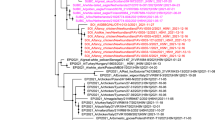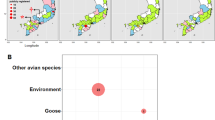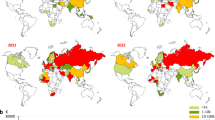Abstract
Highly pathogenic avian influenza (HPAI) H5N1 activity has intensified globally since 2021, increasingly causing mass mortality in wild birds and poultry and incidental infections in mammals1,2,3. However, the ecological and virological properties that underscore future mitigation strategies still remain unclear. Using epidemiological, spatial and genomic approaches, we demonstrate changes in the origins of resurgent HPAI H5 and reveal significant shifts in virus ecology and evolution. Outbreak data show key resurgent events in 2016–2017 and 2020–2021, contributing to the emergence and panzootic spread of H5N1 in 2021–2022. Genomic analysis reveals that the 2016–2017 epizootics originated in Asia, where HPAI H5 reservoirs are endemic. In 2020–2021, 2.3.4.4b H5N8 viruses emerged in African poultry, featuring mutations altering HA structure and receptor binding. In 2021–2022, a new H5N1 virus evolved through reassortment in wild birds in Europe, undergoing further reassortment with low-pathogenic avian influenza in wild and domestic birds during global dissemination. These results highlight a shift in the HPAI H5 epicentre beyond Asia and indicate that increasing persistence of HPAI H5 in wild birds is facilitating geographic and host range expansion, accelerating dispersion velocity and increasing reassortment potential. As earlier outbreaks of H5N1 and H5N8 were caused by more stable genomic constellations, these recent changes reflect adaptation across the domestic-bird–wild-bird interface. Elimination strategies in domestic birds therefore remain a high priority to limit future epizootics.
This is a preview of subscription content, access via your institution
Access options
Access Nature and 54 other Nature Portfolio journals
Get Nature+, our best-value online-access subscription
$29.99 / 30 days
cancel any time
Subscribe to this journal
Receive 51 print issues and online access
$199.00 per year
only $3.90 per issue
Buy this article
- Purchase on Springer Link
- Instant access to full article PDF
Prices may be subject to local taxes which are calculated during checkout






Similar content being viewed by others
Data availability
The avian influenza virus sequences and associated metadata used in this study were downloaded from GISAID and NCBI GenBank. Accession numbers and acknowledgements are provided in Supplementary Data 3. Details of confirmed detections/outbreaks in domestic and wild birds globally are available from World Animal Health Information System, WOAH (https://wahis.woah.org/) and EMPRES-i+ Global Animal Disease Information System, Food and Agriculture Organization (https://empres-i.apps.fao.org/).
Code availability
Data, code and analysis files are available at https://doi.org/10.5281/zenodo.8251324.
References
Wille, M. & Barr, I. G. Resurgence of avian influenza virus. Science 376, 459–460 (2022).
European Food Safety Authority et al. Avian influenza overview December 2021–March 2022. EFSA J. 20, e07289 (2022).
2022-2023 detections of highly pathogenic avian influenza. US Department of Agriculture Animal and Plant Health Inspection Service https://www.aphis.usda.gov/aphis/ourfocus/animalhealth/animal-disease-information/avian/avian-influenza/2022-hpai (2023).
Escalera-Zamudio, M. et al. Parallel evolution in the emergence of highly pathogenic avian influenza A viruses. Nat. Commun. 11, 5511 (2020).
Becker, W. B. The isolation and classification of Tern virus: influenza A-Tern South Africa-1961. J. Hyg. (Lond.) 64, 309–320 (1966).
Chen, H. et al. Establishment of multiple sublineages of H5N1 influenza virus in Asia: implications for pandemic control. Proc. Natl Acad. Sci. USA 103, 2845–2850 (2006).
WHO/OIE/FAO H5N1 Evolution Working Group. Continued evolution of highly pathogenic avian influenza A (H5N1): updated nomenclature. Influenza Other Respir. Viruses 6, 1–5 (2012).
Chen, H. et al. H5N1 virus outbreak in migratory waterfowl. Nature 436, 191–192 (2005).
Ip, H. S. et al. High rates of detection of clade 2.3.4.4 highly pathogenic avian influenza H5 viruses in wild birds in the Pacific Northwest during the winter of 2014–15. Avian Dis. 60, 354–358 (2016).
Engelsma, M., Heutink, R., Harders, F., Germeraad, E. A. & Beerens, N. Multiple introductions of reassorted highly pathogenic avian influenza H5Nx viruses clade 2.3.4.4b causing outbreaks in wild birds and poultry in The Netherlands, 2020–2021. Microbiol. Spectr. 10, e0249921 (2022).
Global Consortium for H5N8 and Related Influenza Viruses.Role for migratory wild birds in the global spread of avian influenza H5N8. Science 354, 213–217 (2016).
Li, Y. T., Su, Y. C. F. & Smith, G. J. D. H5Nx viruses emerged during the suppression of H5N1 virus populations in poultry. Microbiol. Spectr. 9, e0130921 (2021).
van den Brand, J. M. A. et al. Wild ducks excrete highly pathogenic avian influenza virus H5N8 (2014–2015) without clinical or pathological evidence of disease. Emerg. Microbes Infect. 7, 67 (2018).
Leyson, C. M., Youk, S., Ferreira, H. L., Suarez, D. L. & Pantin-Jackwood, M. Multiple gene segments are associated with enhanced virulence of clade 2.3.4.4 H5N8 highly pathogenic avian influenza virus in mallards. J. Virol. 95, e0095521 (2021).
Lewis, N. S. et al. Emergence and spread of novel H5N8, H5N5 and H5N1 clade 2.3.4.4 highly pathogenic avian influenza in 2020. Emerg. Microbes Infect. 10, 148–151 (2021).
Aguero, M. et al. Highly pathogenic avian influenza A(H5N1) virus infection in farmed minks, Spain, October 2022. Euro. Surveill. 28, 2300001 (2023).
Puryear, W. et al. Highly pathogenic avian influenza A(H5N1) virus outbreak in New England seals, United States. Emerg. Infect. Dis. 29, 786–791 (2023).
Poen, M. J. et al. Co-circulation of genetically distinct highly pathogenic avian influenza A clade 2.3.4.4 (H5N6) viruses in wild waterfowl and poultry in Europe and East Asia, 2017–18. Virus Evol. 5, vez004 (2019).
Ramos, S., MacLachlan, M. & Melton, A. Impacts of the 2014-2015 Highly Pathogenic Avian Influenza Outbreak on the US Poultry Sector. Livestock, Dairy, and Poultry Outlook No. (LDPM-282-02) (USDA, 2017).
Gass, J. D. Jr et al. Global dissemination of influenza A virus is driven by wild bird migration through arctic and subarctic zones. Mol. Ecol. https://doi.org/10.1111/mec.16738 (2022).
Reperant, L. A., Fuckar, N. S., Osterhaus, A. D., Dobson, A. P. & Kuiken, T. Spatial and temporal association of outbreaks of H5N1 influenza virus infection in wild birds with the 0 degrees C isotherm. PLoS Pathog. 6, e1000854 (2010).
Swieton, E. et al. Sub-Saharan Africa and Eurasia ancestry of reassortant highly pathogenic avian influenza A(H5N8) virus, Europe, December 2019. Emerg. Infect. Dis. 26, 1557–1561 (2020).
Napp, S., Majo, N., Sanchez-Gonzalez, R. & Vergara-Alert, J. Emergence and spread of highly pathogenic avian influenza A(H5N8) in Europe in 2016–2017. Transbound. Emerg. Dis. 65, 1217–1226 (2018).
Zhu, W. et al. Epidemiologic, clinical, and genetic characteristics of human infections with influenza A(H5N6) viruses, China. Emerg. Infect. Dis. 28, 1332–1344 (2022).
Gass, J. D. Jr et al. Global dissemination of influenza A virus is driven by wild bird migration through arctic and subarctic zones. Mol. Ecol. 32, 198–213 (2023).
Gunther, A. et al. Iceland as stepping stone for spread of highly pathogenic avian influenza virus between Europe and North America. Emerg. Infect. Dis. 28, 2383–2388 (2022).
Pybus, O. G. et al. Unifying the spatial epidemiology and molecular evolution of emerging epidemics. Proc. Natl Acad. Sci. USA 109, 15066–15071 (2012).
Trovao, N. S., Suchard, M. A., Baele, G., Gilbert, M. & Lemey, P. Bayesian inference reveals host-specific contributions to the epidemic expansion of influenza A H5N1. Mol. Biol. Evol. 32, 3264–3275 (2015).
Hill, N. J. et al. Ecological divergence of wild birds drives avian influenza spillover and global spread. PLoS Pathog. 18, e1010062 (2022).
Vijaykrishna, D. et al. Evolutionary dynamics and emergence of panzootic H5N1 influenza viruses. PLoS Pathog. 4, e1000161 (2008).
Linster, M. et al. Identification, characterization, and natural selection of mutations driving airborne transmission of A/H5N1 virus. Cell 157, 329–339 (2014).
Wille, M. et al. Evolutionary features of a prolific subtype of avian influenza A virus in European waterfowl. Virus Evol. 8, veac074 (2022).
Pu, J. et al. Reassortment with dominant chicken H9N2 influenza virus contributed to the fifth H7N9 virus human epidemic. J. Virol. 95, e01578-20 (2021).
Ouoba, L. B. et al. Emergence of a reassortant 2.3.4.4b highly pathogenic H5N1 avian influenza virus containing H9N2 PA gene in Burkina Faso, West Africa, in 2021. Viruses 14, 1901 (2022).
Kalkauskas, A. et al. Sampling bias and model choice in continuous phylogeography: getting lost on a random walk. PLoS Comput. Biol. 17, e1008561 (2021).
Jimenez-Bluhm, P. et al. Detection and phylogenetic analysis of highly pathogenic A/H5N1 avian influenza clade 2.3.4.4b virus in Chile, 2022. Preprint at bioRxiv https://doi.org/10.1101/2023.02.01.526205 (2023).
Rushing, C. S., Royle, J. A., Ziolkowski, D. J. Jr & Pardieck, K. L. Migratory behavior and winter geography drive differential range shifts of eastern birds in response to recent climate change. Proc. Natl Acad. Sci. USA 117, 12897–12903 (2020).
McLean, N. et al. Warming temperatures drive at least half of the magnitude of long-term trait changes in European birds. Proc. Natl Acad. Sci. USA 119, e2105416119 (2022).
Huang, Z. Y. X. et al. Contrasting effects of host species and phylogenetic diversity on the occurrence of HPAI H5N1 in European wild birds. J. Anim. Ecol. 88, 1044–1053 (2019).
Zhang, G. et al. Bidirectional movement of emerging H5N8 avian influenza viruses between Europe and Asia via migratory birds since early 2020. Mol. Biol. Evol. 40, msad019 (2023).
Boni, M. F., Galvani, A. P., Wickelgren, A. L. & Malani, A. Economic epidemiology of avian influenza on smallholder poultry farms. Theor. Popul. Biol. 90, 135–144 (2013).
Liu, S. et al. Control of avian influenza in China: strategies and lessons. Transbound. Emerg. Dis. 67, 1463–1471 (2020).
Lederman, Z. One health and culling as a public health measure. Public Health Ethics 9, 5–23 (2016).
Peyre, M. et al. Avian influenza vaccination in Egypt: limitations of the current strategy. J. Mol. Genet. Med. 3, 198–204 (2009).
Wu, J. et al. Influenza H5/H7 virus vaccination in poultry and reduction of zoonotic infections, Guangdong Province, China, 2017–18. Emerg. Infect. Dis. 25, 116–118 (2019).
Ellis, T. M. et al. Use of avian influenza vaccination in Hong Kong. Dev. Biol. 124, 133–143 (2006).
Grund, C. et al. Highly pathogenic avian influenza virus H5N1 from Egypt escapes vaccine-induced immunity but confers clinical protection against a heterologous clade 2.2.1 Egyptian isolate. Vaccine 29, 5567–5573 (2011).
Suchard, M. A. et al. Bayesian phylogenetic and phylodynamic data integration using BEAST 1.10. Virus Evol. 4, vey016 (2018).
Sagulenko, P., Puller, V. & Neher, R. A. TreeTime: maximum-likelihood phylodynamic analysis. Virus Evol. 4, vex042 (2018).
Smith, G. J. D. et al. Nomenclature updates resulting from the evolution of avian influenza A(H5) virus clades 2.1.3.2a, 2.2.1, and 2.3.4 during 2013–2014. Influenza Other Respir. Viruses 9, 271–276 (2015).
Shepard, S. S. et al. LABEL: fast and accurate lineage assignment with assessment of H5N1 and H9N2 influenza A hemagglutinins. PLoS ONE 9, e86921 (2014).
Hadfield, J. et al. Nextstrain: real-time tracking of pathogen evolution. Bioinformatics 34, 4121–4123 (2018).
Katoh, K. & Standley, D. M. MAFFT multiple sequence alignment software version 7: improvements in performance and usability. Mol. Biol. Evol. 30, 772–780 (2013).
Capella-Gutierrez, S., Silla-Martinez, J. M. & Gabaldon, T. trimAl: a tool for automated alignment trimming in large-scale phylogenetic analyses. Bioinformatics 25, 1972–1973 (2009).
Minh, B. Q. et al. IQ-TREE 2: new models and efficient methods for phylogenetic inference in the genomic era. Mol. Biol. Evol. 37, 1530–1534 (2020).
Rambaut, A., Lam, T. T., Max Carvalho, L. & Pybus, O. G. Exploring the temporal structure of heterochronous sequences using TempEst (formerly Path-O-Gen). Virus Evol. 2, vew007 (2016).
Chernomor, O. et al. Split diversity in constrained conservation prioritization using integer linear programming. Methods Ecol. Evol. 6, 83–91 (2015).
Ayres, D. L. et al. BEAGLE: an application programming interface and high-performance computing library for statistical phylogenetics. Syst. Biol. 61, 170–173 (2012).
Parker, J., Rambaut, A. & Pybus, O. G. Correlating viral phenotypes with phylogeny: accounting for phylogenetic uncertainty. Infect. Genet. Evol. 8, 239–246 (2008).
Bielejec, F. et al. SpreaD3: interactive visualization of spatiotemporal history and trait evolutionary processes. Mol. Biol. Evol. 33, 2167–2169 (2016).
Minin, V. N. & Suchard, M. A. Counting labeled transitions in continuous-time Markov models of evolution. J. Math. Biol. 56, 391–412 (2008).
Bedford, T. et al. Global circulation patterns of seasonal influenza viruses vary with antigenic drift. Nature 523, 217–220 (2015).
Minin, V. N., Bloomquist, E. W. & Suchard, M. A. Smooth skyride through a rough skyline: Bayesian coalescent-based inference of population dynamics. Mol. Biol. Evol. 25, 1459–1471 (2008).
Dellicour, S., Rose, R., Faria, N. R., Lemey, P. & Pybus, O. G. SERAPHIM: studying environmental rasters and phylogenetically informed movements. Bioinformatics 32, 3204–3206 (2016).
McCrone, J. T. et al. Context-specific emergence and growth of the SARS-CoV-2 Delta variant. Nature 610, 154–160 (2022).
Dudas, G. et al. Virus genomes reveal factors that spread and sustained the Ebola epidemic. Nature 544, 309–315 (2017).
Acknowledgements
The computations were performed using research facilities offered by Information Technology Services, the University of Hong Kong. We gratefully acknowledge the staff from the originating laboratories responsible for obtaining the specimens and the submitting laboratories where the genome data were generated and shared by means of GISAID (Supplementary Data 3). We thank J.L.-H. Tsui for valuable discussions about phylogeographic analysis. The funding bodies had no role in the design of the study and collection, analysis and interpretation of data or the writing of the manuscript. Support came from National Institutes of Health contract number 75N93021C00016 and US National Science Foundation awards 1911955 and 2200310.
Author information
Authors and Affiliations
Contributions
V.D. conceived and designed the research. R.X. and X.W. curated the genome datasets. K.M.E. curated the outbreak reports. R.X., K.M.E., X.W. and V.D. performed analysis and designed the figures. R.X., K.M.E., M.W. and V.D. wrote the manuscript with input from S-S.W., M.Z., R.E-S., M.D., L.L.M.P., G.K. and R.J.W. All authors discussed and approved the manuscript.
Corresponding author
Ethics declarations
Competing interests
The authors declare no competing interests.
Peer review
Peer review information
Nature thanks Matthew Scotch and the other, anonymous, reviewer(s) for their contribution to the peer review of this work.
Additional information
Publisher’s note Springer Nature remains neutral with regard to jurisdictional claims in published maps and institutional affiliations.
Extended data figures and tables
Extended Data Fig. 1 Number and proportion of HPAI H5 outbreaks.
Data according to the EMPRESS-i+ Global Animal Disease Information System, Food and Agriculture Organization of the United Nations (FAO) (https://empres-i.apps.fao.org/) from January 2004 to May 2022 coloured by subtype.
Extended Data Fig. 2 Comparison of affected wild bird species by taxonomic order.
Data reported to the EMPRESS-i+ Global Animal Disease Information System, Food and Agriculture Organization of the United Nations (FAO) (https://empres-i.apps.fao.org/) in HPAI H5Nx outbreaks between 2016/17, 2020/21, and 2021/22. Avian orders with fewer than ten outbreaks are not shown.
Extended Data Fig. 3 Spatial distribution of HPAI H5 outbreaks in Europe during 2020–2022.
EMPRESS-i+ Global Animal Disease Information System, Food and Agriculture Organization of the United Nations (FAO) (https://empres-i.apps.fao.org/). Outbreaks are coloured by subtype, and maps were generated using the R package “rnaturalearth”.
Extended Data Fig. 4 Temporal changes in HPAI H5 lineage predominance.
(a) The number of HA sequences coloured by lineage since 2020. (b) Proportional lineage distribution by month inferred from (a).
Extended Data Fig. 5 Evolutionary relationships of Panzootic-2020 (including 2020/21 and 2021/22 resurgence) and JKE-2019 lineage.
Maximum-likelihood tree of Panzootic-2020 (a) and JKE-2019 (b) for each of the eight gene segments. Samples collected in Africa are highlighted in red.
Extended Data Fig. 6 Maximum clade credibility tree of panzootic-2020 clade with branches coloured by geographic region.
The posterior probabilities of regions over 0.8 are annotated in the nodes.
Extended Data Fig. 7 Dynamics of HPAI H5 transmission lineages in clades 2.3.4.4b, 2.3.4.4x, 2.3.2.1 and 2.2.
Virus lineage movements were inferred by continuous phylogeographic analysis for each clade.
Extended Data Fig. 8 The contrasting geographic and host transmission patterns among HPAI H5 2.3.4.4b, 2.3.4.4x, 2.3.2.1, and 2.2 clades inferred from discrete phylogeography.
From left to right, the figures represent regional Markov jumps, regional Markov rewards, host Markov jumps, and host Markov rewards.
Extended Data Fig. 9 Tanglegram of HPAI H5 virus reassortment.
Coloured lines connect each virus across all eight genes, showing incongruence between and within major clades.
Extended Data Fig. 10 Genomic surveillance of HPAI H5 viruses by geographic region from 2005 to 2022.
(a) Temporal changes of all HPAI H5 sequences available on the Global Initiative for Sharing All Influenza Data (GISAID) and NCBI Influenza Virus Resource databases from January 2005 to June 2022 using collection dates. (b) Temporal changes of HPAI H5 sequences per outbreak reported to the Food and Agriculture Organization of the United Nations (FAO). (c) Temporal changes of HPAI H5 sequences per case reported to the World Organization for Animal Health (WOAH).
Supplementary information
Supplementary Information
This file contains a table of contents and Supplementary Tables 1–8.
Supplementary Data 1
Summary of HPAI H5 monophyletic clades for each of the eight gene segments.
Supplementary Data 2
Summary of the proportion of HPAI H5 cases and outbreaks sequenced from 2004 to 2022.
Supplementary Data 3
Acknowledgements for sequences obtained from GISAID and NCBI (accessed on 11 July 2022).
Rights and permissions
Springer Nature or its licensor (e.g. a society or other partner) holds exclusive rights to this article under a publishing agreement with the author(s) or other rightsholder(s); author self-archiving of the accepted manuscript version of this article is solely governed by the terms of such publishing agreement and applicable law.
About this article
Cite this article
Xie, R., Edwards, K.M., Wille, M. et al. The episodic resurgence of highly pathogenic avian influenza H5 virus. Nature 622, 810–817 (2023). https://doi.org/10.1038/s41586-023-06631-2
Received:
Accepted:
Published:
Issue Date:
DOI: https://doi.org/10.1038/s41586-023-06631-2
Comments
By submitting a comment you agree to abide by our Terms and Community Guidelines. If you find something abusive or that does not comply with our terms or guidelines please flag it as inappropriate.



